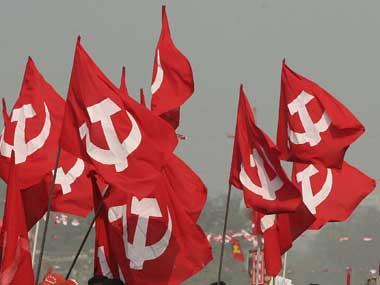Kerala has always been a land of violent student strikes, particularly by the Students Federation of India (SFI), the students wing of the CPM; but when it comes to a landmark uprising against a non-government law college that’s currently rocking the capital city, they seemed to have conveniently embraced moderatism.
While all the student unions — of the Congress, the CPI, the BJP and the MSF (of the Muslim League) — are in it together, the SFI seems to be overtly worried about the possible hurt the agitation could cause the management of the institution than the grievances of the future of the students.
The reason is obvious and simple — its parent CPM is in power and it owes so much to the the institution in question — the Kerala Law Academy — which incidentally is a hot potato for other political parties too.
Ironically, although the Law Academy is patronised by almost all political parties because a large number of their leaders and nominees have studied there, the CPM and the SFI are clearly going out of their way to help the institution. On Saturday, when the Kerala University Syndicate, which may be compared to a state Cabinet in terms of its decision making powers on university matters, met to decide on the complaints of the students, the nominees of the CPM sabotaged the latter’s main demand of the removal of the principal of the college and glossed over other the complaints, including return of a vast tract of government land.
The students have been on a warpath for 20 days now and have been unrelenting in their primary demand that the principal should step down. Their charges against her are serious and include intimidation, malpractice, victimisation, favouritism, caste-based discrimination, abuse of authority, and unlawful misdemeanour. In the eyes of the agitating students, the academy bespeaks a place that’s a law unto itself.
A committee of the syndicate in fact undertook an investigation and endorsed the complaints of the students, but when it came to real action, the CPM/SFI strategically dragged their feet. Instead of taking drastic action as demanded by the students, they soft-pedalled the issue and got away with a minor spank for the principal. They didn’t want to accede to the students’ demands and just debarred her from exam duties for five years. In effect, this would mean nothing because the principal could continue and even do everything she has been allegedly doing, by proxy.
And the students didn’t accept the decision and are continuing with their strike — a curious case of self-proclaimed revolutionary Marxists siding with the management than the protesters, and the latter thumbing their nose at them.
What’s stranger than the decision is the reasoning by the CPM. According to them, the university doesn’t have the authority to remove the principal and any more drastic decision by them would have been challenged by the college-management in a court of law. This argument had never been heard in Kerala in which a student body is speaking for a management under the cover of law or a student body is limiting its decisions for fear of possible legal retaliation.
When one looks back at the violent strikes that the SFI took out against even milder forms of privatisation in education or steps by college managements to augment their educational portfolios in the state, their latest position is bizarre. In the mid-eighties, when an extremely reputed private eye hospital, the only one of its kind then in the state, thought of starting a masters course, the party went on a rampage. The decision was rolled back. Later, when there were was a move of permitting nine polytechniques and one ayurveda college in the private sector, a violent SFI went to the streets again. Ultimately the decision had to shelved. In 1986, they unleashed one of the most violent street protests against a proposed “pre-degree board”, which incidentally was implemented by the CPM-led government in another form later. Similarly, the SFI unrelentingly fought against a vice-chancellor of the Kerala University and even against a cooperative medical college, which the CPM finally took control of. Exactly a year ago, an SFI leader slapped and knocked down former diplomat TP Sreenivasan for his support to collaboration with overseas educational institutions.
The protest in question is historic not just because students have come together against a 50-year old politically influential institution, but because it represented people’s swelling frustration and anger against the devastation caused by privatisation of education in the state. In fact, what led to the protest in Thiruvananthapuram was a continuation of agitation by students against a private engineering college in Trichur district in northern Kerala a few weeks ago following the alleged suicide of a student. The protest spread to other places and finally propelled the Law Academy students as well.
By suggesting something that would be convenient to the management of the Law Academy, the CPM is trying to avoid bigger questions concerning the institution, which incidentally typifies the double-standards of the party and could even expose its complicity.
The reason suggested by the CPM/SFI for its inability to do anything more is that the college is “private”. While asserting that the college is private, the party is not only lying, but is also admitting that the monster of private education in the state had been originally unleashed by them because the institution was established during the second term of the CPM-led government of EMS Naboodthirippadu that had even allotted a huge plot of land in the heart of the city. Did EMS allow the establishment of a private college and even gave government land when privatisation of education was ideologically sacrilegious?
In fact the CPM/SFI is now twisting the truth to suit their decision and to help the management because it was impossible to set up a private college in Kerala in the 1960s and it was established as a society — a public institution — in which both the government and eminent citizens were stakeholders. The Law Academy prospectus clearly states this — that it was established as a society in 1966.
The then government was both politically and legally right to allow such an institution because the purpose was noble. In fact, many institutions in the state and elsewhere in India had been established as societies and had gone on to become national icons without diluting its public character. However, in the case of the Law Academy which was established as a society with government participation and patronage cunningly started calling itself “private” at some stage and begun behaving like one. There is no record when this transition happened and whether it’s even legally possible. The academy literature calls itself private now. Doesn’t the Kerala government, which gave precious land to it because it was a public institution and it had a stake, have a problem? Wouldn’t the registrar of societies know? Interestingly, even if the CPM doesn’t have a problem, its veteran leader and former chief minister VS Achuthanandan finds it odd and wants the government to take it back.
Another strange charge against the institution is that it doesn’t have appropriate affiliation to the University of Kerala because it doesn’t have any records on the same or the academy hasn’t produced any papers to counter the charge. A lawyer, who went to court against the academy in the 1980s insist that there is no affiliation, but the academy is yet to clarify. Unless the academy makes the papers of affiliation public, the charges would stick.
The strike against the Law Academy in fact has a larger context — it’s the test of the people’s tolerance to the ills of privatisation of education. It’s really ironical that the party that brought the revolutionary “Kerala Education Bill” in 1957 to contain privatisation of education, is today siding with a management that is inimical to the interests of the students. What the party and its proxies effectively hide behind its ideological pomposity is that it’s as responsible to the present rot as the Congress and its allies are.
The decline of Kerala’s famous model of public funded education began in 1991, when the Congress-led UDF was in power, and in response, the CPM unleashed an agitation in which five of its workers were killed; but when the party itself came back to power in 1996, it rolled out a Plus Two liberalisation drive.
When the Congress (UDF) returned in 2001, it further liberalised the education sector. The subsequent CPM government in 2006 did nothing to stop it. The Congress-led UDF started it and the CPM-led LDF nurtured it quite generously. In fact, had the CPM applied the breaks, the damage could have been limited because between 2001, when the UDF started the mayhem, and 2006, the number of engineering colleges in the state (now, there are 160 engineering colleges for 14 districts at a whopping average of 11-12 colleges per district) was still under 50. But instead of stemming the rot, the CPM-led government under VS Achuthanandan, allowed about 30 more colleges and when the UDF came back under Oommen Chandy’s leadership, it added another 30-odd.
Today, many of the CPM leaders have no qualms in sending their children to such self-financing colleges. The privatisation of higher education has been so perverse that half the engineering seats in the state have no takers and many colleges have only single-digit pass percentages. Incidentally, Kerala is one of the highest consumers of education loans in India — there cannot be a better indicator of private sector providing poor quality education and trapping families in debt-trap. According to the all India survey of the Ministry of Human Resources (2013), out of the 654 colleges in the state, 498 are private. If the capital expenditure on education was 5.7 percent in the eighth plan period, by the 11th plan, it fell to 2.1 percent. Other than providing salaries, the government is practically doing nothing. The prestigious government colleges and schools of the past have become dens of political lumpen and goons. And by being in government alternatively with the Congress, the CPM is equally responsible although it conveniently pontificates every now and then. Even while being dubious in his stand on the Law Academy, the Kerala Chief Minister Pinarayi Vijayan is waxing eloquent about how privatisation has ruined education.
Interestingly, the Marxists have a strange history that many don’t know in the state — in the 1940s, when CP Ramaswamy Iyer wanted to nationalise primary school education, the communists (then undivided) opposed it for whatever reasons. Today, by siding with the Law Academy management, they are showing their instinct again, notwithstanding the fact that SFI is also notionally on strike.
Along with the charges of the students, the government should also investigate these two critical questions about the Law Academy: How did a society established with state government participation become “private” and where is its accreditation? Otherwise, the state will be complicit in gross illegality.


)




)
)
)
)
)
)
)
)